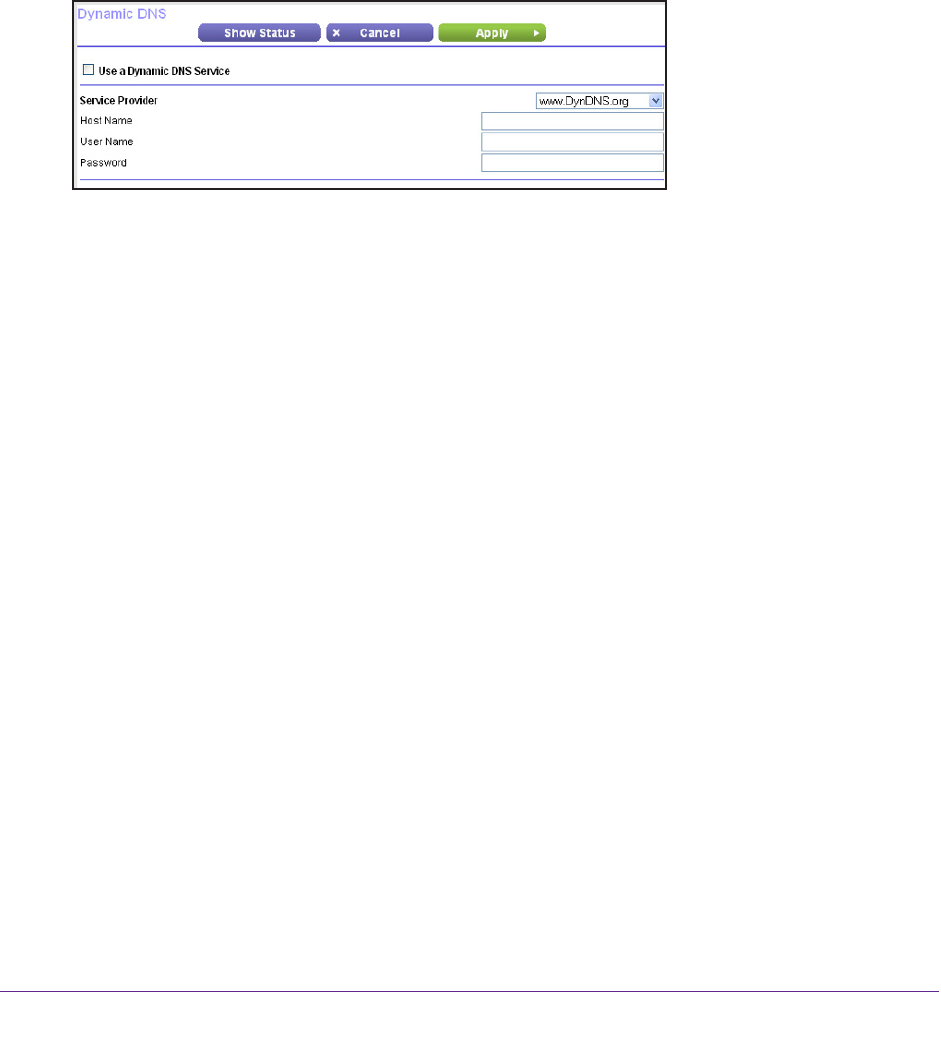Netgear PR2000 User Manual Page 116
- Page / 145
- Table of contents
- TROUBLESHOOTING
- BOOKMARKS
Rated. / 5. Based on customer reviews



Advanced Settings
116
Trek N300 Travel Router and Range Extender PR2000
2. Enter www.routerlogin.net or www.routerlogin.com in the web browser address bar.
The login screen displays.
3. Enter the T
rek user name and password.
The user name is admin.
The default password is password. The user name and
password are case-sensitive.
4. Click the OK button.
The BASIC Home screen displays.
5. Select ADV
ANCED > Advanced Setup > Dynamic DNS.
6. Register for an account with one of the Dynamic DNS service providers whose URLs are in
the Service Provider list.
7. Select the Use a Dynamic DNS Service check box.
8. Select the URL of your Dynamic DNS service provider
.
For example, for DynDNS.org, select www
.DynDNS.org.
9. T
ype the host name (or domain name) that your Dynamic DNS service provider gave you.
10. T
ype the user name for your Dynamic DNS account.
Enter the name that you use to log in to your account, not your host name.
11. T
ype the password (or key) for your Dynamic DNS account.
12. Click the Apply button.
Your changes are saved.
Static Routes
Static routes provide more routing information to your Trek. Under usual circumstances, the
Trek has adequate routing information after it has been configured for Internet access, and
you do not need to configure more static routes. You must configure static routes only for
unusual cases such as multiple Treks or multiple IP subnets on your network.
As an example of when a static route is needed, consider a situation with the following
elements:
• Y
our primary Internet access is through a cable modem to an ISP.
- NETGEAR Trek 1
- N300 Travel Router and Range 1
- Extender 1
- Compliance 2
- Trademarks 2
- Contents 3
- Chapter 5 USB Port 4
- Chapter 6 Security 4
- Chapter 7 Administration 4
- Chapter 8 Advanced Settings 5
- Chapter 9 Troubleshooting 5
- Get to know your Trek 6
- Unpack Your Trek 7
- Position Your Trek 7
- Prepare Your Trek 8
- Get to Know Your NETGEAR Trek 9
- Internet Mode Switch 9
- Figure 2. Internet via switch 9
- Indicator LEDs 10
- Figure 3. Indicator LEDs 10
- Table 1. Status LEDs 10
- Hardware Setup 11
- Power Inputs 12
- Power plug 12
- Antenna Orientation 13
- Product Label 13
- WiFi Range Extender Setup 16
- DO DON’T 17
- WiFi Bridge Setup 20
- Connect to the Trek 22
- Trek Setup Preparation 23
- Gather ISP Information 23
- Types of Logins and Access 23
- NETGEAR genie Setup 24
- ******** 25
- Upgrade the Trek Firmware 26
- Change the Password 26
- Password Recovery 27
- To recover your password: 28
- Manual Method 29
- Wi-Fi Protected Setup Method 30
- Internet Setup 34
- Basic Wireless Settings 40
- To change the WPA settings: 43
- Attached Devices 44
- Profile Settings 45
- Specify custom settings 47
- Setup Wizard 48
- To launch the Setup Wizard: 48
- WAN Setup 50
- To change the WAN settings: 50
- Default DMZ Server 51
- Change the MTU Size 53
- Table 2. Common MTU sizes 53
- To change the MTU size: 54
- LAN Setup 54
- To change the LAN settings: 55
- Use the Trek as a DHCP Server 56
- Set Up Address Reservation 58
- To reserve an IP address: 58
- Quality of Service Setup 60
- To set up QoS: 61
- Scroll down 62
- Enhance your local network 66
- Enhance Your Local Network 67
- Set Up Network Storage 68
- View or Configure a USB Drive 69
- USB Port 70
- To view network folders: 72
- To add a network folder: 73
- 6. Click the Edit button 74
- To edit a network folder: 75
- Specify Approved USB Devices 76
- Share Photos and Multimedia 78
- Set Up a Network Printer 81
- 6. Click the Connect button 83
- Security 87
- To block services: 88
- Schedule Blocking 90
- To schedule blocking: 90
- Manage your network 93
- View Trek Status 94
- Router Information Pane 94
- Internet Port Pane 95
- Statistics 96
- Connection Status 98
- Wireless Settings Pane 100
- Administration 101
- Specify Log Settings 102
- To specify log settings: 103
- Manage the Configuration File 104
- Back Up Settings 104
- Update the Trek Firmware 106
- Fine-tune your network 108
- Advanced Wireless Settings 109
- Control the Wireless Radio 109
- Set Up a Wireless Schedule 110
- View or Change WPS Settings 111
- To specify WPS settings: 111
- Advanced Settings 112
- Dynamic DNS 115
- To set up Dynamic DNS: 115
- Static Routes 116
- To set up a static route: 117
- Remote Management 119
- Universal Plug and Play 121
- Traffic Meter 122
- Scroll to view 123
- Diagnose and solve problems 126
- Quick Tips 127
- Troubleshoot with the LEDs 127
- Power LED Is Off 128
- LEDs Never Turn Off 128
- Internet Port LED is Off 128
- WiFi LED is Off 129
- Cannot Log In to the Trek 129
- Cannot Access the Internet 130
- Troubleshoot PPPoE 131
- Troubleshooting 132
- Changes Not Saved 133
- Incorrect Date or Time 133
- Wireless Connectivity 134
- View the Trek specs 138
- Factory Settings 139
- Technical Specifications 140
- Supplemental Information 141








Comments to this Manuals